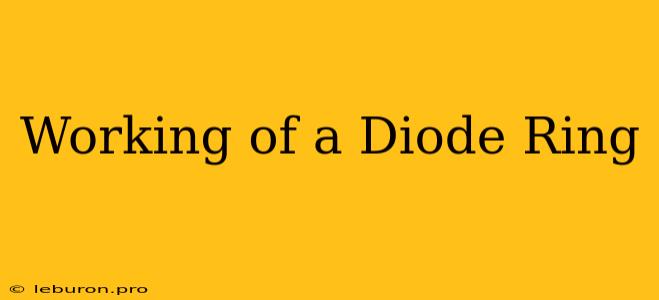Understanding the Versatile Functioning of a Diode Ring
The diode ring, a deceptively simple arrangement of diodes connected in a circular configuration, plays a pivotal role in various electronic circuits. Its functionality, rooted in the unique properties of diodes, allows it to perform tasks ranging from voltage regulation and signal switching to phase shifting and AC-to-DC conversion. This article delves into the intricate working principle of a diode ring, dissecting its behavior in different circuit configurations and showcasing its diverse applications in the realm of electronics.
The Diode Ring: A Foundation of Rectification
At the core of a diode ring's functionality lies the diode itself. A diode, a semiconductor device, exhibits the characteristic of allowing current flow in only one direction. This unidirectional current flow property forms the bedrock for the diode ring's ability to rectify alternating current (AC) into direct current (DC). The diode ring, essentially a closed loop of diodes, cleverly utilizes this characteristic to achieve different outcomes depending on the applied voltage and circuit configuration.
Basic Diode Ring Configuration
A basic diode ring typically consists of four diodes arranged in a circular pattern, with each diode's anode connected to the cathode of the next diode, forming a closed loop. The input voltage is applied across two diametrically opposite points of the ring, while the output is taken from the remaining two points. This setup exhibits a unique voltage switching behavior, allowing only one pair of diodes to conduct at a time, based on the polarity of the applied voltage.
How a Diode Ring Rectifies
When a positive voltage is applied to one pair of points in the diode ring, the two diodes connected to this pair conduct, effectively creating a path for current flow through the ring. The other pair of diodes remains reverse-biased, blocking current flow. Conversely, when a negative voltage is applied to the same pair of points, the conduction path shifts to the other pair of diodes, as they now become forward-biased, while the previously conducting diodes become reverse-biased. This switching action effectively rectifies the alternating current, resulting in a pulsating direct current output.
Diverse Applications of the Diode Ring
The diode ring's simple yet versatile functionality opens up a wide range of applications in various electronic circuits:
1. Voltage Regulation
The diode ring, when configured with a zener diode in parallel with one of its arms, can serve as a voltage regulator. The zener diode, with its characteristic of maintaining a constant voltage across its terminals when reverse-biased, acts as a voltage reference. The diode ring ensures that the output voltage remains regulated at the zener diode's breakdown voltage, effectively limiting the output voltage fluctuations.
2. Signal Switching
The diode ring's switching behavior can be utilized for signal switching applications. By connecting the input signal to the diode ring and using a control voltage to select the conducting pair of diodes, the input signal can be routed to different outputs based on the control voltage level. This mechanism finds use in various electronic circuits, such as multiplexers and demultiplexers.
3. Phase Shifting
The diode ring's ability to shift the phase of an input signal makes it useful in phase shifting circuits. Depending on the diode ring configuration and the applied voltage, the output signal can be shifted by different phase angles. This capability finds application in various signal processing tasks, such as frequency filtering and signal synchronization.
4. AC-to-DC Conversion
The diode ring, with its inherent rectification ability, can be used to convert AC signals to DC signals. By incorporating a capacitor across the output of the diode ring, the pulsating DC output is smoothed into a relatively steady DC voltage. This fundamental principle forms the basis for power supplies used in various electronic devices.
Conclusion
The diode ring, despite its apparent simplicity, embodies a wealth of functionality. Its ability to rectify, regulate, switch, and shift signals makes it an indispensable component in the realm of electronics. From basic power supply circuits to complex signal processing systems, the diode ring's versatility shines through, highlighting its pivotal role in enabling various electronic functionalities. Understanding the working principle of this remarkable circuit, along with its diverse applications, is paramount for anyone seeking a deeper understanding of the fundamental building blocks of electronics.
